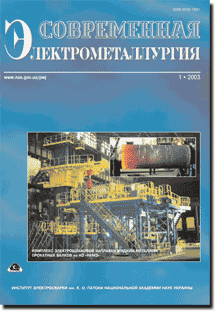

ELECTROSLAG TECHNOLOGY
Ryabtsev A.D., Troyansky A.A., Mastepan V.Yu. and Samborsky M.V. About electrical conductivity of fluxes of CaF2-Ca system. P. 2
New procedure of measuring electrical conductivity of metal-containing slags, used for ESR in chamber-type furnaces, is offered. Values of electrical conductivity of slag of CaF2-Ca system are determined.
Biktagirov F.K. Application of non-consumable electrode electroslag process for melting, refining and treatment of metals. Report 2. P. 4
Examples of use of the non-consumable electrode electroslag process for processing of a non-compact metal-containing charge to produce different ferroalloys and master alloys, metal refining and cladding are given. ELECTRON BEAM PROCESSES
Antonyuk S.L., Molyar A.G., Kalinyuk A.N. and Zamkov V.N. Titanium alloys for aircraft industry of Ukraine. P. 9
Distribution of alloying elements and impurities in length and section of 400 mm diameter ingot from titanium alloys of VT6, VT22, T-110 grades, produced by the method of electron beam melting with an intermediate crucible (EBMC) is investigated. Macro- and microstructures of forgings from these alloys are examined. Mechanical properties of alloys after deformation and heat treatment are determined.
Movchan B.A., Ustinov A.I., Polishchuk S.S. and Melnichenko T.V. Formation of quasi-crystalline structures in annealing of microlayer coatings (Ti, Cr)-Si. P. 13
Structural changes in microlayer coatings (Ti, Cr)-Si in the process of isothermal annealing at temperatures 900, 1000 and 1100 oC are studied. Microlayer structure was produced by electron beam evaporation from two ingots (Ti-Cr and Si) and condensation in vacuum of non-mixing vapour flows. It is shown that in diffusion interaction between the layers the microlayer structure is destroyed and the structure on the base of icosahedral phase (or approximate to it) is formed.
Zhuk G.V. Interaction of steel fibers with aluminium matrix in producing composite material using method of electron beam dispersion of melt. P. 17
Process of producing the composite material, aluminium matrix/steel fibers, using the method of melt dispersion from an intermediate crucible during the electron beam remelting is described. Effect of technological conditions on nature of interaction of fiber with matrix is investigated. Macro- and microstructures of samples are examined and the composition of forming phases is determined. PLASMA-ARC TECHNOLOGY
Shapovalov V.A., Yakusha V.V. and Gnizdylo A.N. Thermal field of a single crystal at a combined heating. P. 20
The thermal fields of tungsten single crystals were studied in the conditions of plasma-induction zone melting (PIZM) using a mathematical model. Relationships of change in pool depth and curvature of solid-liquid phase interface were obtained indicating the efficiency of effect of a combined heating on the formation of structure of single crystals. It is shown that it is necessary to use a two-section inductor for thermal field control in growing single crystals of refractory metals.
Kiselevsky F.N., Shapovalov V.A., Dolinenko V.V., Shcherbakov P.A., Yakusha V.V. and Gnyzdilo A.N. Microcomputer panel of operator-technologist of ACS TP of growing single crystals. P. 23
It is shown that the most rational way of producing large oriented single crystals of refractory metals with stable properties using technology of plasma-induction zone melting is associated with the development of ACS TP. The comprehensive description of one of the functional elements of a partially automated control system of the process of growing crystals, i.e. microcomputer panel of the operator-technologist, is presented. The use of the developed panel enables the operator to make the monitoring and control of the process easier, and also to decrease the effect of a human factor on the reproducibility of properties of the crystals produced. GENERAL PROBLEMS OF METALLURGY
Grigorenko G.M., Borisova A.L., Borisov Yu.S., Adeeva L.I., Doroshenko L.K. and Rupchev V.L. Investigation of interphase interaction of ferrotitanium with boron carbide in powder mixtures for deposition of thermal coatings. P. 26
Interaction of ferrotitanium with boron carbide, which is accompanied by a significant exothermal effect, is investigated. It was established that the maximum exothermal effect is attained at ferrotitanium interaction with boron carbide in powder mixture of the following composition: 85 wt.% FeTi + 15 wt.% B4C with the formation of reaction products TiB2, TiC, Fe2B, Fe3B, Fe3C. This powder mixture is the promising material for coating deposition using the methods of thermal spraying.
Lilius K.R. and Gasik M.M. Functional gradient materials: new materials science solutions. P. 30
Problems of development and realization of new materials science solutions based on the technology of functional gradient materials (FGM) are considered. Tendencies in the development of theory and technology of FGM are analyzed, examples of solutions for producing metallic composites, hard alloys, protective coatings, and also more complex components for power engineering are given. INFORMATION
International Seminar "Modern Technologies and New Structural Materials in Chemical Engineering and Industry". P. 35
75th birthday anniversary of Professor Boris A. Movchan. P. 39
Information for contributors to the journal "Advances in Electrometallurgy". P. 40
(You are viewing the simplified file contents)
